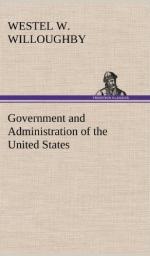No man by himself produces everything he wants to use, but devotes his time to the production of some few things, and the surplus that he does not use, he exchanges for other things made by other men. In rude stages of society this is done by a direct exchange of one commodity for another, e.g. so much wheat or corn for a gun or plow. This is a very imperfect and cumbersome method, which cannot be employed in our present complicated transactions of buying and selling. There thus early developed the use of money, or the practice of referring the value of all things to one standard, usually the precious metals: so that, instead of trading 20 bushels of corn for a plow, where it would be necessary to go to the great trouble of finding a man who had a plow, and also wanted your corn, you sell it for so much money, and with this money you buy a plow. Money is thus but a medium of exchange and a standard of value.
In the United States, as in most nations, money has always been made by the Government, and the Government alone, so that one certain fixed system may prevail. For the sake of convenience, money is made of various kinds and denominations, and United States money may conveniently be regarded under the five following divisions: 1. _#Gold Coin, Gold Bullion, and Gold Certificates.#_—There are six gold coins: (1) the eagle, $10 piece; (2) the double eagle, $20 piece; (3) the half eagle, $5; (4) the quarter eagle, $2.50; (5) the $3 piece, and (6) the $1 piece. The three last are but little used. The gold bullion, or gold in bars and blocks uncoined, is for all practical purposes as good as the coin, and in foreign trade is much used, it being more convenient to handle. Besides the gold coin and bullion there are in circulation gold certificates. These are paper, the same in general appearance as the ordinary bank-note, and certify that an equivalent amount of gold has been deposited with the Treasurer of the United States, and that the holder of the certificate has the right to obtain the gold for it at any time. This does not increase the amount of money in circulation, as for every one issued just so much coin is withdrawn and stowed away in the Treasury. The certificates are used simply for convenience, and in order to avoid the necessary wear of the coin if in constant use. These certificates are of the denomination of $20.
2. #_Silver Dollars and Silver Certificates_#.—There is no silver bullion circulating as money, for a silver dollar does not contain a dollar’s worth of silver, as the gold dollar does of gold, and the silver bullion is thus of different value (less value), according to weight, than the silver dollar. The silver certificates are similar to the gold certificates, already described, and certify that an equivalent amount of silver has been deposited in the Treasury.




